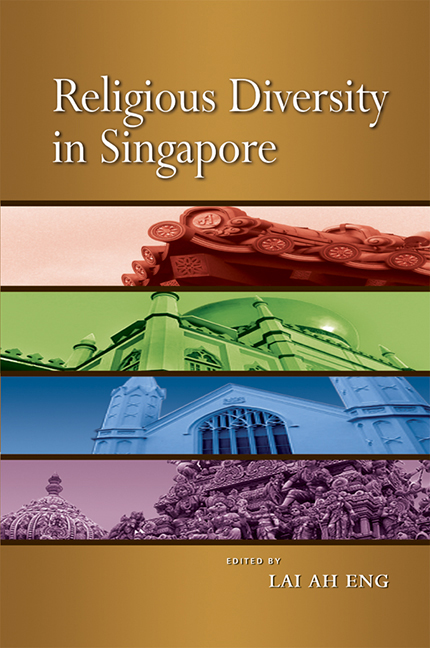Book contents
- Frontmatter
- Contents
- List of Figures and Tables
- List of Appendices
- FOREWORD
- PREFACE
- Acknowledgements
- The Contributors
- Abbreviations
- Glossary
- INTRODUCTION
- PART I The Landscape of Religious Diversity
- PART II Religion in Schools and Among the Young
- PART III Religion in the Media
- PART IV Religious Organizations in Social Services
- PART V Interfaith Issues and Interaction
- 23 Religious Diversity, Toleration and Interaction
- 24 Negotiating Christianity with Other Religions: The Views of Christian Clergymen in Singapore
- 25 The Inter-Religious Organization of Singapore
- 26 Interactions among Youth Leaders of Different Faiths: Realities from the Ground and Lessons Learnt
- 27 Building Bridges between Christians and Muslims: A Personal Journey
- 28 Conclusion: Some Remarks on Religious Diversity in Singapore
- Index
23 - Religious Diversity, Toleration and Interaction
from PART V - Interfaith Issues and Interaction
Published online by Cambridge University Press: 21 October 2015
- Frontmatter
- Contents
- List of Figures and Tables
- List of Appendices
- FOREWORD
- PREFACE
- Acknowledgements
- The Contributors
- Abbreviations
- Glossary
- INTRODUCTION
- PART I The Landscape of Religious Diversity
- PART II Religion in Schools and Among the Young
- PART III Religion in the Media
- PART IV Religious Organizations in Social Services
- PART V Interfaith Issues and Interaction
- 23 Religious Diversity, Toleration and Interaction
- 24 Negotiating Christianity with Other Religions: The Views of Christian Clergymen in Singapore
- 25 The Inter-Religious Organization of Singapore
- 26 Interactions among Youth Leaders of Different Faiths: Realities from the Ground and Lessons Learnt
- 27 Building Bridges between Christians and Muslims: A Personal Journey
- 28 Conclusion: Some Remarks on Religious Diversity in Singapore
- Index
Summary
INTRODUCTION: MANAGING RELIGIOUS DIVERSITY
It is a fact that many contemporary societies are diverse in many respects, including matters of religion. A central issue of politics is therefore how to manage such diversity. But there are many who are still not prepared to accept this starting point, and to acknowledge the existence of diversity as a more or less permanent feature. Some believe that the current diversity, although it is real and deep, is not lasting and that our social life will eventually converge on a comprehensive set of fundamental values and perspectives. The idea that reasonable people would agree, when the distorting features of social life are removed, remains the perennial, and sometimes dangerous, dream of some social reformers. It can be dangerous if sustained attempts to secure rational agreement fail, and continued disagreement is then attributed to perversity and a stubborn refusal to acknowledge what one must know to be the single truth. The suppression of those who know that they are in error may then be seen as justified.
Rejecting Exclusivism
There are others who think that while religious diversity exists, it is merely superficial and conceals a fundamental agreement deep down about important matters. Among some cosmopolitan religious thinkers, there is a strong conviction that any form of exclusion is undesirable. They seek a central core of shared convictions by ignoring the details of doctrinal differences, focusing instead on the highest and most abstract common denominator — the belief in God. But even when reduced to this bare minimum, not all religions are in agreement because not all religions believe in God. Replacing God with something more nebulous, some ultimate, transcendent reality, will not solve the problem, for there is disagreement about the nature of this reality, for example, with respect to whether human beings survive death or the form of such survival. Again, some specific matters of detail, such as the divinity of Christ, are central to one religion, but rejected by others. In any case, even if all the traditional religions can be shown to share a fundamental set of doctrines, the programme of rejecting exclusivism remains unattainable because it leaves out agnostics and atheists.
- Type
- Chapter
- Information
- Religious Diversity in Singapore , pp. 557 - 570Publisher: ISEAS–Yusof Ishak InstitutePrint publication year: 2008

